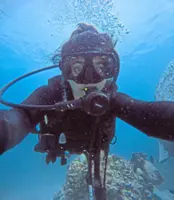Soft coral species and a sea apple at an unsurveyed site in Exmouth Gulf. The extensive, sheltered waters of the gulf and its variety of ecosystems are home to an exceptionally high level of biodiversity. Photos: Rolex/Tom Cannon
A spectacular wilderness which is home to nearly 2,000 species of fauna, the Exmouth Gulf and Ningaloo Coast World Heritage Area’s varied habitats include nutrient-giving salt flats, seagrass beds, macro-algal reefs, hard corals and filter-feeder-dominated seabeds, which support a wealth of biodiversity.
This marine paradise – where part of the world’s largest population of humpback whale mothers congregate to nurse their young – was recognised as a Hope Spot by legendary oceanographer Sylvia Earle’s non-profit Mission Blue network in 2019, thanks to the lifelong commitment of marine biologist Ben Fitzpatrick to the ocean.





